
Salix pentandra, the bay willow, is a species of willow native to northern Europe and northern Asia. The scientific name refers to the male flowers having five stamens. The English name derives from the resemblance of the leaves to those of the bay laurel; other common names include bay-leaved willow and laurel willow. Its glossy leaves make it more decorative than many other willows, so it is often planted as an ornamental tree.

Salix nigra, the black willow, is a species of willow native to eastern North America, from New Brunswick and southern Ontario west to Minnesota, and south to northern Florida and Texas.

Salix lasiolepis is a species of willow native to western North America.

Salix lucida, the shining willow, Pacific willow, red willow, or whiplash willow, is a species of willow native to northern and western North America, occurring in wetland habitats. It is the largest willow found in British Columbia.
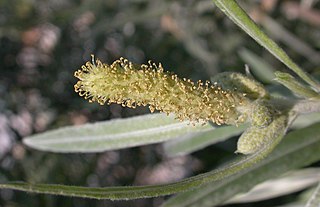
Salix exigua is a species of willow native to most of North America except for the southeast and far north, occurring from Alaska east to New Brunswick, and south to northern Mexico. It is considered a threatened species in Massachusetts while in Connecticut, Maryland, and New Hampshire it is considered endangered.

Arctostaphylos obispoensis is a species of manzanita, known by the common names bishop manzanita and serpentine manzanita, endemic to California.
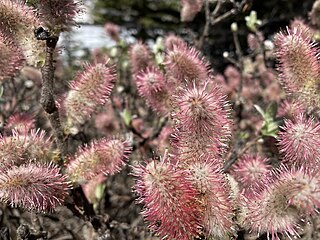
Salix barrattiana is a species of flowering plant in the willow family known by the common name Barratt's willow. It is native to North America, where it is distributed across Alaska and western Canada, with also a few populations in Montana and Wyoming. These disjunct populations are probably relics from a time when the climate was colder. The southernmost population is technically in Wyoming, but it is located at the Montana state line and it is limited to one clone of all-staminate plants within an area of 100 square meters (1,100 sq ft) in a high-elevation habitat.

Salix bebbiana is a species of willow indigenous to Canada and the northern United States, from Alaska and Yukon south to California and Arizona and northeast to Newfoundland and New England. Common names include beaked willow, long-beaked willow, gray willow, and Bebb's willow. This species is also called red willow by Native Americans according to The Arctic Prairies Appendix E by Ernest Tompson Seton.

Quercus turbinella is a North American species of oak known by the common names shruboak, turbinella oak, shrub live oak, and gray oak. It is native to Arizona, California, New Mexico, Utah, Colorado, and Nevada in the western United States. It also occurs in northern Mexico.
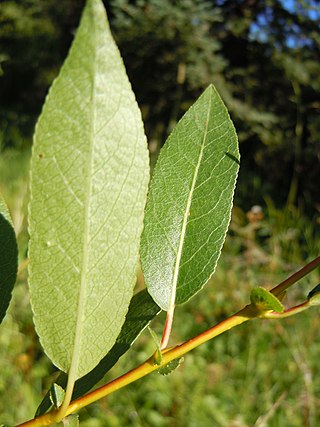
Salix boothii is a species of willow known by the common name Booth's willow.
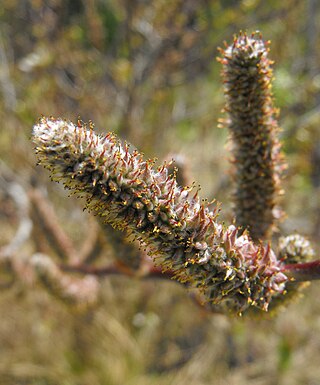
Salix breweri is a species of willow known by the common name Brewer's willow. It is endemic to California, where it can be found in the serpentine soils of the Coast Ranges in and around the San Francisco Bay Area. It is a riparian shrub growing one to four meters in height. The yellowish or reddish brown stems are lightly hairy in texture, the small twigs coated in velvety fibers. The leaves are generally lance-shaped, smooth-edged or gently toothed, and partially rolled under along the edges. The leaves are hairy, with the lower surfaces often quite woolly. Mature leaves may be 14 centimeters long or more. The inflorescence is a catkin which develops before the plant produces leaves. The catkins are up to 5 or 6 centimeters long, the female ones lengthening further as the fruits develop.

Salix drummondiana is a species of willow known by the common name Drummond's willow. It is native to western North America from Yukon and the Northwest Territories in the north to California and New Mexico in the south. It is a resident of moist mountain habitats, including forests, riverbanks, and floodplains.
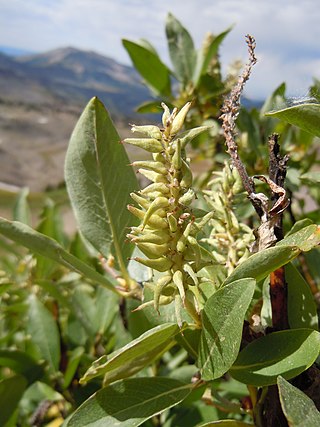
Salix eastwoodiae is a species of willow known by the common names mountain willow, Eastwood's willow, and Sierra willow. It was first described by Bebb in 1879 as Salix californica. This name was later found to be illegitimate, as Lesquereux had given the same name to a fossil willow in 1878.

Salix hookeriana is a species of willow known by the common names dune willow, coastal willow, and Hooker's willow.

Salix jepsonii is a species of willow known by the common name Jepson's willow. it is named for renowned California botanist Willis Linn Jepson.
Salix ligulifolia is a species of willow known by the common name strapleaf willow. It is native to the western United States. It grows in moist and wet habitat, such as riverbanks, swamps, and floodplains, such as in the Sierra Nevada in California.

Salix melanopsis is a plant species known by the common name dusky willow. It is native to western North America from British Columbia and Alberta to California and Colorado, where it grows in many types of moist and wet habitat, such as riverbanks and subalpine mountain meadows, on rocky and silty substrates.
Salix orestera is a species of willow known by the common name Sierra willow, or gray-leafed Sierra willow. It is native to the Sierra Nevada of California and western Nevada, where it grows in moist areas in high mountain subalpine and alpine climates. It can also be found in Oregon.

Salix sitchensis is a species of willow known by the common name Sitka willow.
Salix brachycarpa is a species of flowering plant in the willow family known by the common names barren-ground willow, small-fruit willow and shortfruit willow.

















